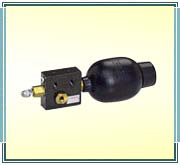Hydraulic Accumulator

A hydraulic accumulator is a pressure storage reservoir in which a non compressible hydraulic fluid is retained under pressure from an external source. Its main function is to store hydraulic energy and is necessary, make the energy available again to the system. A hydraulic accumulator is also referred to as the capacitance of the system.
Types of Accumulators
The different types of accumulators include:
A. Dead weight type
The dead weight accumulator consists of a piston loaded with a dead weight and moving within a cylinder that exerts pressure on the hydraulic oil. The dead weight may be of some heavy material such as iron, concrete block, pig or scrap iron etc. For minimum leakage past the piston, it must be a precision fit in the accumulator tube to ensure a long life.
Advantages
Their advantage is that the pressure remains constant for the full stroke. They supply large volumes of fluid under high pressure. They can serve several hydraulic systems at a time and are most often used in ill and central hydraulic systems.
Disadvantages
The dead weight type accumulators, however, have some disadvantages too. Being very bulky, the larger sizes are extremely expensive, particularly those delivering high pressures and volumes.
B. Spring loaded type
Whether single-spring or multiple-spring type, the springs in this accumulator, act against a hydraulic piston forcing the fluid into the hydraulic system. A spring loaded accumulator consists of a cylinder body, a movable piston and a spring. The spring applies force to the piston. As fluid is pumped to it, the pressure in the accumulator is determined by the compression rate of the spring.
Advantages
These accumulators are usually smaller less expensive than the dead weight type and mounting is easy. They are built directly into the power unit.
Disadvantages
They supply a small volume of oil at low pressure. The pressure does not remain constant, the accumulator pressure reaching its peak as the spring compresses and drops to a minimum as the springs approach free length. It has to be taken care of that the leakage oil is vented from the spring chamber.
C. Hydro-pneumatic type
The hydro-pneumatic accumulators are the most commonly used accumulators and apply force to the liquid by using a compressed gas that acts as the spring. It uses only dry nitrogen as there is a danger of exploding an air-oil vapor, in the case of compressed air.
The different types of hydro-pneumatic accumulators used are:
1. Non-separator type, but not used due to possibility of foaming
It consists of a cylinder with hydraulic fluid and the charging gas with no separation between them. They are generally used on die casting machines or other similar places. They are always to be mounted vertically.
2. Piston
It consists of a cylinder body and a movable piston. The gas that occupies the volume above the piston is compressed as the cylinder body is charged with liquid.
3. Diaphragm
It consists of two metal hemispheres which are separated by flexible, synthetic rubber diaphragm. The storing action is effected by the compression of the volume of nitrogen enclosed in the diaphragm.
4. Bladder
It consists of a synthetic polymer rubber bladder like chloroprene, nitrile, etc. inside a metal (steel) shell. The bladder is filled with compressed gas. It responds quickly for receiving or expelling flow of oil. There is always a possibility of bladder failure that needs to be taken into consideration.
Usage
The hydraulic accumulators are applicable for hydraulic shock suppression are suitable for leakage compensation. The accumulators are the source of power during power failures. They aptly hold high pressure for long periods without keeping the pump running.
They have wide applicability in large hydraulic presses, diesel engine starters, hydraulically operated hospital beds, farm machinery, landing gear mechanism on airplanes, hatch cover in ships, lifts, trucks, etc.
Guidelines for Safety
1. In order to avoid the danger of explosion, the air or oxygen should not be used or allowed to enter the system. 2. Repair or connection of pressure gauge should be done after the release of fluid pressure. 3. The gas precharge pressure should lie below the minimum operating pressure. 4. Bladders should be hanging by the gas valve and blown up with air to their full length and not stored folded. 5. The accumulators should be always fitted with robust bracket and a pressure relief valve. 6. There should be a non-return valve fitted with an accumulator to prevent oil from flowing back to the pump.

0 Comments:
Post a Comment
Subscribe to Post Comments [Atom]
<< Home